Winning in Physical and Digital Retail With the Power of Data
After over a year of debate about whether shoppers will go back into stores, I think it’s been decided: it will be a blend of both, but to keep shoppers loyal to a brand or store, unique value must be proved out.
Is it the brand story, the price, the quality, the customization or the service level? Using data, you can determine what it is that shoppers care about, so that you provide an experience that will keep shoppers engaged, spreading the word and coming back for more.
Here are a few ways brands can maximize their presence both in and outside of the store:
Hyper-personalization: Some shoppers like the thrill of the “find,” sifting through endless bins and racks or pages of items, but we know that too much choice can be detrimental. Using data, we can ensure that as shoppers come into a store (via curated items ready in a fitting room) or browse online (personalized digital shelf), they are presented with a specialized group of items based on their interests, past purchases, shape and size.
A personal shopper can be relied on less when AI models have been effectively trained. In addition, new technology, like Fit Match is allowing brands to create digital avatars based on a scan, opening the door for custom products or recommendations based on your exact body, which leads to less returns. Brands can implement AI-powered site search tools and merchandising solutions to ensure shoppers receive the right recommendations.
Transformational visualization tools: Traditionalstatic product detail pages work for fast-moving consumer goods, but for higher-ticket items, shoppers want more. They want to see how a dress falls, the size of a handbag or how a TV image appears.
There are now so many technologies, like Obsess that allow websites to become a more interactive, educational experience. And while it can be an undertaking to make all items in 3D, data can be used to understand exactly which items or at what price point shoppers need this level of detail to easily convert. Brands should work with their agency insights and analytics teams to understand the product types or price thresholds where these tools will be the most impactful to employ.
Access: The scarcity mentality that has developed from supply chain issues and limited-time/small run items like sneakers or celebrity merchandise presents an opportunity for brands to create a relationship with loyal customers, giving them exclusive access to items that, based on data, they know will appeal to them. So, whether they send a personalized email or invite them in the store for an exclusive shopping event, they’ve strengthened their relationship with the shopper. Brands should work with their agency team to segment their customer base, understand their purchase drivers and develop an engagement strategy to strengthen the lifetime value of their loyal shoppers.
Inventory: Nothing is more frustrating than getting an ad for something that you fall in love with, only to click on it to learn that the item is out of stock. This is an easy fix in the physical and digital world. Inventory data must be integrated with media buys to ensure that what is advertised, is available and even in that shopper’s size. In a physical location, associates can curate a selection of in-stock items based on the customers size, removing the potential for disappointment. Digital shelf tools integrated with campaign management software are more important than ever to ensure automated tracking and optimization. This has been core for my company and, through our proprietary set of offerings, we’ve been able to help our clients monitor their brands’ inventory levels to buy media at the right time and place, to pull back on product-specific keyword spend when inventory levels have been detected as ‘low’ or ‘out of stock’, and tactically beat the competition when their products’ inventories are at a vulnerable status.
Data only works when you put it to work, but once you do, it can unlock so many opportunities to enhance a shopping experience, whether in the store or online. When shoppers see the positive effects of what sharing more of their personal attributes can do, they’re likely to continue to share and be a lifetime customer to a brand that caters to them.
(66)
Report Post



